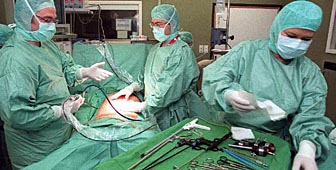New hope for kidney transplant patients

Researchers at Zurich University have found that kidneys taken from a fresh corpse keep working as long as those taken from a donor with a heartbeat.
Faced with a severe worldwide shortage of kidney donors, doctors in Zurich have been seeking new sources of the organ.
Currently, most kidneys are harvested from people who are brain dead but whose heart is still functioning, pumping life-giving blood through the body’s organs.
Many doctors believe that if they wait until a person’s heart has stopped to remove the kidneys, the organs will become damaged from lack of oxygen and will not survive as long when they are transplanted.
The researchers’ study, published in the New England Journal of Medicine, found that there is “no difference” in the long-term survival rate of kidneys from donors with a heartbeat and those removed from donors without a heartbeat.
Survival rate the same
“Many doctors think that this delayed graft function will lead to a poor long-term outcome,” Dr Markus Weber, one of the report’s authors told swissinfo.
“Our study shows clearly that this is not true. We compared these organs from donors with and without a heartbeat and the outcome is almost identical.”
Weber, a surgeon at the University Hospital Zurich, believes the findings – based on 244 transplants between 1985 and 2000 – will increase kidney transplant patients’ chances of finding a donor.
“Centres around the world are reporting that they were able to increase the rate of transplants by 25 per cent [by using donors with still hearts]. In two cases – in the Netherlands and Spain – donor rates increased by up to 40 per cent,” he says.
Only 30 to 40 centres globally use organs from non-heart-beating donors. Weber points out that the Zurich centre increased the rate of kidney transplants by 11 per cent when it started using donors without a heartbeat.
However, while waiting times are shrinking and transplant rates are increasing, Weber says the problem is still far from solved.
“In Switzerland there were 670 patients on the waiting list at the start of 2002 and we are performing around 250 kidney transplantations a year. And so even if we can increase this number by ten per cent, it will not solve the problem. We must continue to use older donors, and we have to encourage living donation.”
Complications
The researchers did note, however, that in the moments after operation there was a “significantly higher” incidence of delayed organ function among patients who received kidneys from cadavers (48.4 per cent) than among patients who received kidneys from donors with a heartbeat (23.8 per cent).
This means that recipients of kidneys from donors without a heartbeat often need dialysis for the first ten to 14 days after surgery.
However, the study found that organ survival after ten years was 78.7 per cent for kidneys from donors whose heart had stopped beating and 76.7 per cent for kidneys from donors with a heartbeat.
The findings also raise hopes for transplants using other organs. Weber says they are now ready to go a step further and consider what can be done to help procure other organs, such as the liver.
“I think the next organ will be the liver. There are reports from the United States and United Kingdom that livers have been procured with good results from donors whose hearts have stopped.”
by Samantha Tonkin with agencies

In compliance with the JTI standards
More: SWI swissinfo.ch certified by the Journalism Trust Initiative
You can find an overview of ongoing debates with our journalists here . Please join us!
If you want to start a conversation about a topic raised in this article or want to report factual errors, email us at english@swissinfo.ch.